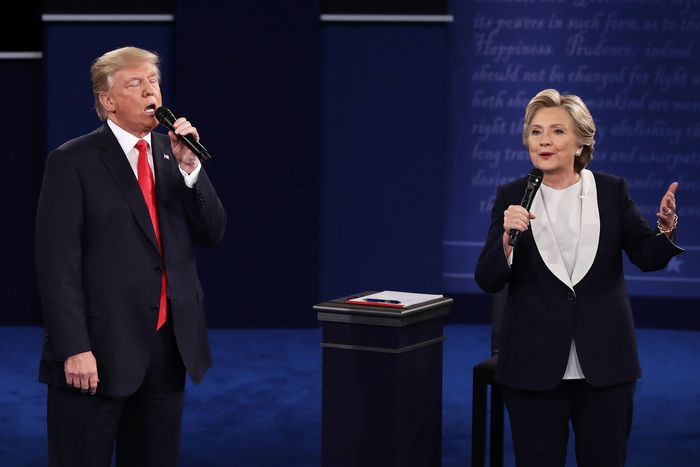
Hardly a day goes by without some political chatter about robust Democratic fundraising in this midterm election, as an important part of the central story of a potential Democratic “wave.” Such talk intensified when third-quarter fundraising numbers started dribbling out. Here’s a bulletin from Cook Political Report’s David Wasserman:
Democrats’ staggering success in third quarter fundraising reports injects some last-minute uncertainty. An astounding 112 Democrats outraised GOP opponents in Republican-held seats between July and September. Of the 93 GOP incumbents who were outraised, 20 are currently in our Likely Republican column and 23 in Solid Republican. Democrats’ late dominance in the air wars could produce several Election Night surprises.
Superstitious Democrats might think back to a similar line of discourse in 2016. This is from a late-September Los Angeles Times piece that year:
Hillary Clinton is using her fundraising dominance to unleash all manner of modern voter tools that Donald Trump’s organization is too cash-poor, disorganized or uninterested in to use …
“We have never seen an imbalance as great as we are seeing this election,” said Eitan Hersh, a political science scholar at Yale University and author of “Hacking the Electorate.” If Republicans fail to shore up their ground game in the crucial swing states, he said, they risk giving Clinton an advantage of as much as 3 percentage points in them.
That’s a good reminder that Clinton and her team’s resources (a total of $1.19 billion for the cycle, as opposed to Team Trump’s $646 million) gave her an advantage not just in TV ads, but in get-out-the-vote infrastructure. Many a prognosticator looked at signs of a tightening race in the fall, intoned “Clinton ground game,” and figured she’d win anyway.
Some of that alleged advantage was probably imaginary, and there’s also evidence that Trump used his resources more strategically, as the Associated Press reported in December of 2016:
Brad Parscale, Trump’s digital director who was empowered with spending decisions across the campaign, credited strategic last-minute investments with helping propel the political newcomer to victory.
Specifically, he told The Associated Press, the campaign and Republican Party spent about $5 million in get-out-the-vote digital advertising targeted in the final few days to Michigan, Wisconsin, Pennsylvania and Florida. That proved critical; some of those states were won by razor-thin margins …
Clinton’s top campaign aides have acknowledged in postelection appearances that it didn’t always spend money in the right places.
Her campaign manager Robby Mook said at a gathering of political strategists and journalists last week at Harvard University that he regretted not putting more staff in Michigan
But all that probably mattered a lot less than the basic fact held by most political scientists that campaign spending is generally not that important in presidential general elections unless it’s so lopsided as to be virtually uncontested. Why?
Well, for one thing, by the time major-party nominations are awarded, both candidates have near-universal name identification, which is one of the few things massive advertising really can achieve. That was particularly true in 2016, given the decades that both Clinton and Trump had spent in the glare of national media. For another, presidential nominees receive far more free (or “earned”) media than they could possibly buy. And for still another, partisan polarization has significantly reduced the number of persuadable voters, and that’s particularly true at the presidential level.
But it’s a different matter down ballot — and in midterms, all the candidates are down ballot. Historically (at least since reliable numbers have been available), over 90 percent of House candidates with higher campaign spending won. It’s difficult to disentangle cause and effect here, since incumbents, who tend to win for reasons other than their campaign war chests, attract a lot of contributions. But one very clear thing is that little-known challengers need money to build name ID, and those in mixed or hostile partisan territory need even more to stimulate turnout and win over swing voters, such as they are. Still, it’s not often the decisive factor — again, so long as one candidate doesn’t have an overwhelming advantage.
What we are seeing this year, however, is potentially historic, in part because Democrats have begun to master the art of attracting small individual donations, while Republicans are doing much more poorly at the small-money game than in the past, as Nate Silver explains:
The result is a fundraising disparity the likes of which we’ve never seen before — at least not in recent years. (Our data on House fundraising goes back to 1998.) In the average House district, the Democratic candidate has raised 64 percent of the money this cycle, or almost two-thirds. Likewise, the Democrat has raised an average of 65 percent of the money in districts rated as competitive by the Cook Political Report. In all previous years in our database, no party had averaged more than 56 percent of the money in these competitive districts.
The fundraising numbers are so good for Democrats — and so bad for Republicans — that it’s hard to know quite what to make of them.
The one thing that is pretty clear is that the ability of Democratic candidates facing favored Republican incumbents to raise so much money against them has increased the playing field of competitive — or potentially competitive — districts. It’s like someone went onto a field crowded with people on a violently stormy night, handing out lightning rods: The number of strikes that will occur if there is a lot of electricity in the air will be accordingly higher. So in the end, the impact of money on election 2018 will depend on such nonmoney factors as the size and strength of a Democratic “wave.” If it’s not there, all of those well-financed Democratic challengers in red territory may just get the consolation prize of coming close — much like Hillary Clinton.






























